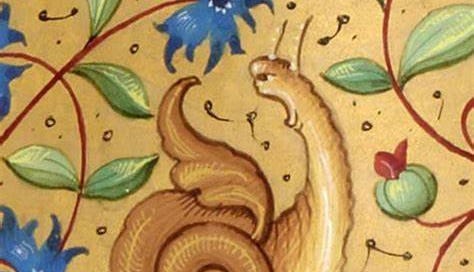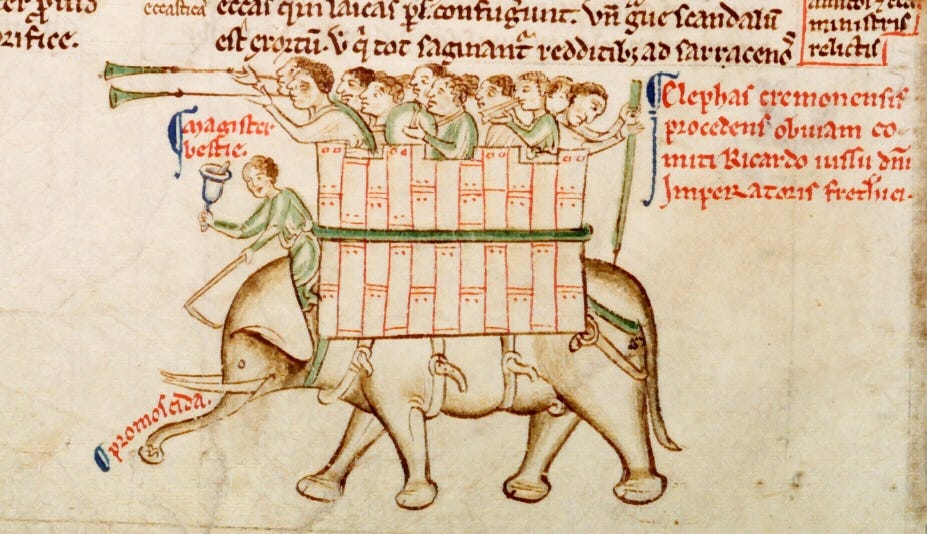Snails and Elephant Tales in Medieval and Renaissance Manuscripts
Knowledge is power?
This is an odd article, but it simply bears repeating, because it’s entirely new to me. While researching the battle of San Romano, I came across an obscurely placed, and frankly random cut of an academic paper, or perhaps very brief journal article called the Virgin Snail, by Helen S. Etlinger. In it the author quotes a few contemporary scholars discussing the iconography of the snail, which apparently represents the Virgin Mary, check it out:
Francis of Retz in 1400 argued on behalf of the symbolism thus, "If the dew of the clear air can make the sea snail pregnant, then God in virtue can make His mother pregnant."
Filippo Piconelli, in the 17th century argued, "In honor of the Virgin Mary of the Annunciation who conceives the divine Word in her with the sole virtue of the Holy Spirit, serves the company of the Snail with the motto: Fertile in pure dew (RORE PVRO FOECVNDA).”
Yea.
This popped up in on the tail end of an accademic paper called, The Political Significance of Uccello's Battle of San Romano in the Journal of the Warburg and Courtauld Institutes, Vol. 41 (1978), pp. 313-316 (5 pages). Fun little rabbit hole. Rabbit riding snail down a hole? Marginalia intensifies—
Related to this are references I found of the Lionfante, an image we all recognize from Fiore, but one that I kept coming across around the city of Sienna and in Crusader guidebooks, namely a guidebook printed in 1518 by Manciolino’s printer, Nicolo d’Aristotile d’Rossi.
The Lionfante, seen here, depicted as an elephant with a castle on its back was a symbol often used by individuals who had made a pilgrimage to the Holy Land, or been on crusade. The Lionfante’s usage gained popular appeal in guidebooks to the Holy Land after the publication of the seminal work of Niccolo da Poggibonsi’s, Libro da Oltramare (1346-1350). A work that later influenced a print run of, Viaggo da Venetia al Sancto Sepolchro et al Monte Sinai, in 1518, which crossed the desk of Niccolo d’Aristotile d’Rossi.
On the Italian mainland, the Lionfante was a symbol often utilized by Jewish communities to represent their heritage. For example, the Contrada of Sienna, the Torre, who represented the regions Jewish quarter used the Lionfante as their symbol when they competed in the famous Palio di Siena. 1
Fiore doesn’t allude to an association that fits the classic or contemporary use case of the Lionfante, but it’s interesting that he utilized the iconography rather than a regular elephant, that is, an elephant without a castle on its back. However, his description of the elephant strangely jives really well with Matthew Paris’, Chronica Majora, where it’s presumed elephants don’t have knees and couldn’t get up if they fell over. Fiore says in his Segno, “I am the elephant and I carry a castle as cargo, And I do not kneel nor lose my footing.”
Later, in 1470’s Christian I of Denmark founded the Chivalric order, the Order of the Elephant2, Christian was the European monarch that knighted Annibale Bentivoglio in 14743.
None of this is inherently relevant to the normal content we publish on this channel, but sometimes while doing research you come across obscure things that are fun and deserve to be shared. We’d love to hear your encounters with Medieval and Renaissance iconography in the comments below.
Moore, Kathryn Blair. “The Disappearance of an Author and the Emergence of a Genre: Niccolò Da Poggibonsi and Pilgrimage Guidebooks between Manuscript and Print.” Renaissance Quarterly, vol. 66, no. 2, 2013, pp. 357–411. JSTOR, https://doi.org/10.1086/671582. Accessed 15 Aug. 2023.
Griffiths, Gordon. “The Political Significance of Uccello’s Battle of San Romano.” Journal of the Warburg and Courtauld Institutes, vol. 41, 1978, pp. 313–16. JSTOR, https://doi.org/10.2307/750874. Accessed 15 Aug. 2023.








